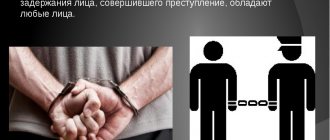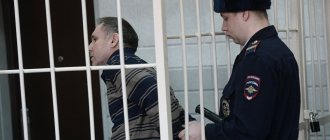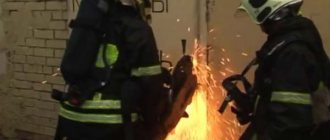Criminal Code of the Russian Federation in the latest edition:
Article 108 of the Criminal Code of the Russian Federation. Murder committed by exceeding the limits of necessary defense or by exceeding the measures necessary to apprehend the person who committed the crime
1. Murder committed when exceeding the limits of necessary defense, -
shall be punishable by correctional labor for a term of up to two years, or restriction of liberty for a term of up to two years, or forced labor for a term of up to two years, or imprisonment for the same term.
2. Murder committed by exceeding the measures necessary to apprehend the person who committed the crime -
shall be punishable by restriction of freedom for a term of up to three years, or forced labor for a term of up to three years, or imprisonment for the same term.
Return to the table of contents of the document: Criminal Code of the Russian Federation in the latest edition
Comments on Article 108 of the Criminal Code of the Russian Federation
Article 108 of the Criminal Code of the Russian Federation provides for criminal liability for the commission of two independent crimes:
- murder committed when the limits of necessary defense were exceeded;
- murder committed while exceeding the measures necessary to apprehend the person who committed the crime.
Object of crime . The immediate object of these two crimes is human life.
The objective side is expressed in action aimed at taking life. The elements of crimes are material.
The subjective side of murder under Art. 108 of the Criminal Code of the Russian Federation, is characterized by guilt in the form of sudden direct or indirect intent. Causing death by negligence by exceeding the limits of necessary defense or by exceeding the measures necessary to apprehend the person who committed the crime does not entail criminal liability.
The subject of the crime provided for in Art. 108 of the Criminal Code of the Russian Federation, general - a sane individual who has reached the age of sixteen. Murder when exceeding the limits of necessary defense or the limits of measures necessary to detain a person who has committed a crime committed by a person aged fourteen to fifteen years does not entail criminal liability
On the concept of necessary defense and exceeding its limits, see Article 37 of the Criminal Code of the Russian Federation and comments to it.
On the concept of causing harm when detaining a person who has committed a crime and exceeding the limits necessary for detention, see Article 38 of the Criminal Code of the Russian Federation and comments to it.
Explanations on the application by courts of legislation on necessary defense and causing harm when detaining a person who has committed a crime are contained in Resolution of the Plenum of the Supreme Court of the Russian Federation dated September 27, 2012 No. 19.
Killing beyond the limits of necessary defense
Murder in excess of the limits of necessary defense assumes that the perpetrator acted with the right to the necessary defense, but exceeded its limits.
The Resolution of the Plenum of the Supreme Court of the Russian Federation dated September 27, 2012 N 19 draws attention to circumstances that exclude liability for exceeding the limits of necessary defense, i.e. for intentionally causing death or serious harm:
1) repelling an attack involving violence dangerous to the life of the defender or another person, or with an immediate threat of using such violence (Part 1 of Article 37 of the Criminal Code of the Russian Federation);
2) the consequences occurred due to the unexpectedness of the attack (Part 2.1 of Article 37 of the Criminal Code of the Russian Federation);
3) the limits of necessary defense were not exceeded (Part 2 of Article 37 of the Criminal Code of the Russian Federation).
Socially dangerous attack involving violence dangerous to the life of the defender or another person
In paragraph 2 of the Resolution of the Plenum of the Armed Forces of the Russian Federation of September 27, 2012 N 19, under socially dangerous encroachment associated with violence dangerous to the life of the defender or another person, it is proposed to understand an act that, at the time of its commission, created a real danger to the life of the defender or another person. The presence of such an encroachment may be evidenced, in particular, by:
- causing harm to health that creates a real threat to the life of the defender or another person (for example, injury to vital organs);
- the use of a method of assault that creates a real threat to the life of the defender or another person (use of weapons or objects used as weapons, strangulation, arson, etc.).
An immediate threat of violence that is dangerous to the life of the defender or another person can be expressed, in particular, in statements about the intention to immediately cause death or harm to health to the defender or another person, dangerous to life, demonstrations to the attacker of weapons or objects used as weapons, explosive devices if, taking into account the specific situation, there were grounds to fear that this threat would be carried out.
The unexpectedness of the attacker's actions
In paragraph 4 of Resolution No. 19 of September 27, 2012, the Plenum also indicated that when clarifying the question of whether the actions of the attacker were unexpected for the person defending himself, as a result of which the defender could not objectively assess the degree and nature of the danger of the attack (Part 2.1 of Article 37 of the Criminal Code of the Russian Federation ), the court should take into account the time, place, setting and method of the attack, the events preceding the attack, as well as the emotional state of the person defending himself (state of fear, fright, confusion at the time of the attack, etc.). For example, an attack committed at night with penetration into a home, when the defending person, in a state of fright, was unable to objectively assess the degree and nature of the danger of such an attack, may be recognized as unexpected.
An assault involving violence that is not dangerous to the life of the defender or another person, or with an immediate threat of such violence
Clause 3 of the Resolution No. 19 dated September 27, 2012 reveals the concept of an assault involving violence that is not dangerous to the life of the defender or another person, or with an immediate threat of such violence. It is against such an encroachment that it is possible to exceed the limits of necessary defense if the encroachment was not unexpected. The Plenum gave an approximate list of such attacks (beatings, causing minor or moderate harm to health, robbery committed with the use of violence not dangerous to life or health), and also indicated that these could be any intentional and careless acts provided for by the Special part of the Criminal Code of the Russian Federation, which, although not associated with violence, however, taking into account their content, can be prevented or suppressed by causing harm to the offender.
Exceeding the limits of necessary defense
In paragraph 11 of the Resolution of the Plenum of the Armed Forces of the Russian Federation dated September 27, 2012 N 19, attention is drawn to the fact that “criminal liability for causing harm occurs for the defender only if the limits of necessary defense are exceeded, i.e. when it is established in the case that the defender resorted to protection from the attack specified in Part 2 of Article 37 of the Criminal Code of the Russian Federation, in such ways and means, the use of which was clearly not caused by the nature and danger of the attack, and unnecessarily intentionally caused the offender serious harm to health or death. At the same time, liability for exceeding the limits of necessary defense occurs only in the case when it is established in the case that the defender was aware that he was causing harm that was not necessary to prevent or suppress a specific socially dangerous attack.”
Thus, exceeding the limits of necessary defense is the deliberate, conscious infliction of death or grievous harm on the offender, when this was not caused by the nature and danger of the attack.
What circumstances are taken into account to conclude that there are signs of necessary defense?
In paragraph 13 of Resolution No. 19 of September 27, 2012, the Plenum recommends deciding whether there are signs of exceeding the limits of necessary defense on the basis of a number of circumstances. In particular, such as the object of the attack, the method chosen by the offender to achieve the result, the severity of the consequences that could occur if the attack was completed, the presence of the need to cause death or serious harm to health to prevent or suppress the attack, the place and time of the attack, the unexpectedness of the attack, the number of persons who encroached and defended themselves, the presence of weapons or other objects used as weapons, the ability of the defending person to repel the attack. In addition, the Plenum recommends that the issue of exceeding the limits of necessary defense be resolved on the basis of any other circumstances that could affect the real balance of forces between the attacker and the defender.
Conditions for recognizing signs of necessary defense in a person’s actions when the method and means of defense are disproportional
Not every discrepancy between protective measures and the nature and danger of the attack can be considered an excess of the limits of necessary defense. In paragraph 14 of the Resolution No. 19 dated September 27, 2012, it is explained that the person defending himself, due to the emotional disturbance caused by the attack, cannot always correctly assess the nature and danger of the attack and, as a result, choose a proportionate method and means of defense. Therefore, the actions of the person defending cannot be considered as committed in excess of the limits of necessary defense if the harm caused, although it turned out to be greater than the harm prevented, but in causing the harm there was no obvious discrepancy between the protective measures and the nature and danger of the attack.
In what case is an act considered committed in a state of necessary defense?
An act is considered committed in a state of necessary defense, without exceeding its limits, if the defending person caused the offender:
- by negligence any harm, including careless causing of death;
- intentional harm to health, not exceeding the limits of moderate severity inclusive (infliction of physical pain, blows, beatings, intentional minor harm to health, imprisonment);
- death or serious harm to health, if this corresponded to the nature and degree of public danger of the attack.
The presence of aggravating circumstances under Part 2 of Art. 105 of the Criminal Code of the Russian Federation
The presence of circumstances provided for in clauses “a”, “d”, “e”, part 2 of Art. 105 of the Criminal Code of the Russian Federation does not exclude the qualification of an act as committed when the limits of necessary defense were exceeded or in a state of necessary defense. The presence of other aggravating circumstances, Part 2 of Art. 105 of the Criminal Code does not allow the act to be qualified in this way, since it implies the absence of a state of necessary defense.
What points are taken into account?
The Criminal Code is quite loyal to excess of self-defense. However, during the proceedings, even the smallest details are taken into account that could show whether there was intent or not and what the elements of the crime were.
A crime committed by a civilian or an official is considered in a similar manner:
- A general assessment of the situation is underway. Investigators collect testimony from witnesses (if any) and determine the circumstances of the incident. They also find out whether the attack could have caused death or serious health problems, and whether the permissible level of self-defense was exceeded.
- The offender undergoes a medical examination, during which it is determined whether he was injured in a violent manner, as well as his condition at the time of the crime (the influence of alcohol, drugs, medications, psychological trauma). A psychological examination also reveals the attitude of the criminal towards the murder and the murdered person.
- During the investigation, the officer in charge of the case collects information about the life of the criminal before the murder was committed, and based on this, builds a unique portrait of the person.
- Investigators are also obliged to find out whether the people involved in the case knew each other, respectively, the criminal and the victim, whether the conflict could have matured before the fateful day or not, and if it could, then who could have initially been the aggressor.
- The investigative team conducts an experiment in which the criminal shows how the crime was committed, and also evaluates the weapons used by both sides.
It is especially important to note the fact that the decision on punishment is made not by the inquiry officer, not by the investigator, but by the court. Therefore, you should not trust what law enforcement officers say during interrogations and agree to their conditions.
In addition, everything that has ever been written down by people leading the case needs to be read and understood. If the suspect’s testimony is recorded incorrectly, then there is no need to sign such papers under pressure, since the case, with the slightest change in the description of the situation, can be reclassified from Article 108 to 105, 107 or 109. The difference is very vague, and the punishment is completely different.
Based on objective data about the situation, the killer of the attacker may not receive a sentence, but may go under Article 37 of the Criminal Code, which, although it does not provide for murder, has a very important point in its interpretation. Part 2.1 of this article says that exceeding the necessary self-defense is permissible if a person did not realize the actual level of threat and could not objectively assess the situation due to the speed of events, without being under the influence of any drugs.
However, it is impossible to prove that the subject of the crime should not be held liable under Article 108, but falls under Article 37. This is confirmed by the scandalous statement of Anton Tsvetkov, a member of the Public Chamber of the Russian Federation, who in July last year noted the fact that a woman does not have the right to kill a rapist due to the absence of a threat to life, and therefore she will suffer the most severe punishment possible for Article 108 Part 1 .








